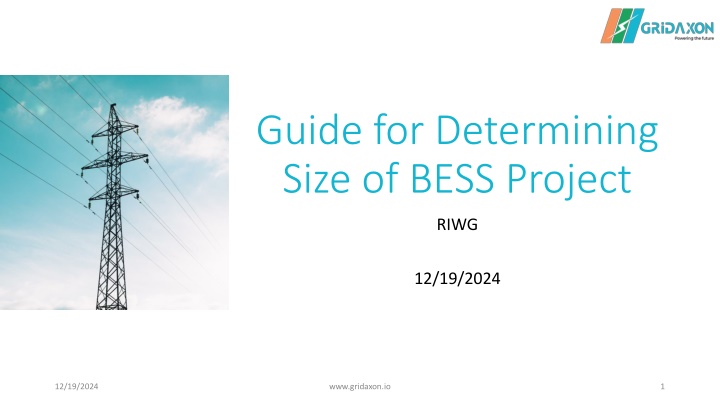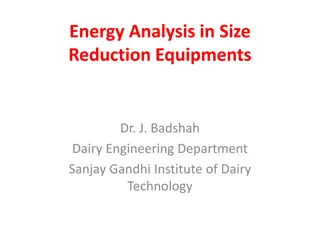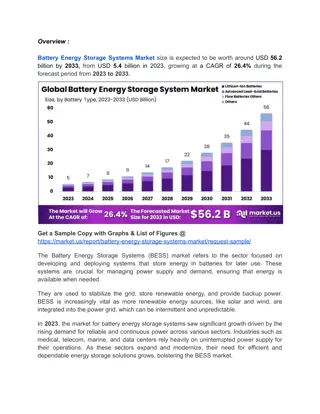
Determining Size of BESS Project: Key Considerations and Requirements
Discover the key considerations and requirements for determining the size of a Battery Energy Storage System (BESS) project, including accounting for aux load, Main Power Transformer (MPT) rating, and leveraging reactive study results. This guide helps in understanding the implications of project size and reactive capabilities on system performance.
Download Presentation

Please find below an Image/Link to download the presentation.
The content on the website is provided AS IS for your information and personal use only. It may not be sold, licensed, or shared on other websites without obtaining consent from the author. If you encounter any issues during the download, it is possible that the publisher has removed the file from their server.
You are allowed to download the files provided on this website for personal or commercial use, subject to the condition that they are used lawfully. All files are the property of their respective owners.
The content on the website is provided AS IS for your information and personal use only. It may not be sold, licensed, or shared on other websites without obtaining consent from the author.
E N D
Presentation Transcript
Guide for Determining Size of BESS Project RIWG 12/19/2024 12/19/2024 www.gridaxon.io 1
Key Considerations What should be the project size (MW) in RIOO main page? At the 34.5kV bus, but how to account for the aux load? What should be the MVA rating of Main Power Transformer? How can we make use of (preliminary) Reactive Study results in determining the project size? www.gridaxon.io 4/12/2025 2
Reactive Study Requirements Reactive Requirement (+/-Mvars/100 MW) 50 Reactive Capability 40 32.9 30 Minimum Overexcited Reactive Capability (Lagging) 20 Reactive Power Mvars 10 1.05 0 1.04 1.04 0.95 1.0 -10 Minimum Underexcited Reactive Capability (Leading) -20 -30 -32.9 -40 Reactive Capability -50 POI Voltage (p.u.) www.gridaxon.io 4/12/2025 3
A Sample 200 MW BESS Project Meter 1 (M1) Measurement at the POI Meter 2 (M2) Measurement at the 34.5kV side of MPT Meter 3 (M3) Measurement at the 34.5kV bus, from all feeders before aux load i.e., M3 = M2 + Aux load www.gridaxon.io 4/12/2025 4
A Sample 200 MW BESS Project ERCOT wants RIOO to show the MW size of the project at the 34.5 kV bus For any given project, there will be a family of possible values depending on: The size of the aux load and whether it is known or can be estimated The reactive operating conditions (lag, neutral, or lead), and system conditions (POI voltage) In this example, the owner considers the project to be a nominal 200 BESS The MPT was ordered before the reactive study was done When the reactive study is done, if the MPT is found to be overloaded at any of the four study points, the project will either have to be downsized or redefined as a Self-Limiting Facility www.gridaxon.io 4/12/2025 5
Details of Valid Reactive Study Load Flows A B C D E F G H I J K L M N O P Q R Lowest voltage at inverter terminals, pu Highest voltage at inverter terminals, pu MW MVAR Delivered to 34.5kV side of MPT (meter 2) MVA MW MVAr Delivered to 34.5kV Bus (meter 3) MW MVAr Delivered to POI (meter 1) MVA Delivered to 34.5kV side of MPT (meter 2) Delivered to 34.5kV side of MPT (meter 2) sum(MW at Inverter Terminals) sum(MVAR at Inverter Terminals) Delivered to 34.5kV Bus (meter 3) POI Reactive Test OLTC Tap Position Delivered to POI (meter 1) Delivered to POI (meter 1) MW Aux Load MVAR Aux Load Dispatch Voltage, pu HSL Max Lag 2 (1.25%) 1.005 1.008 201.35 67.35 212.32 202.27 105.59 228.17 210.31 119.39 208.17 106.39 5.90 0.80 0.95 LOP HSL Max Lag Max Lead 2 (1.25%) 8 (-5%) 0.988 1.017 0.993 1.020 20.64 201.94 69.68 -68.82 72.67 213.34 20.75 202.69 73.97 -38.04 76.83 206.23 26.90 210.31 75.79 -26.14 26.65 208.59 74.77 -37.24 5.90 5.90 0.80 0.80 1.00 LOP Max Lead 8 (-5%) 1.005 1.007 20.73 -67.82 70.92 20.82 -63.93 67.23 26.90 -62.52 26.72 -63.13 5.90 0.80 HSL Max Lag 16 (10%) 1.012 1.014 201.38 67.30 212.33 202.31 103.97 227.46 210.31 118.53 208.21 104.77 5.90 0.80 1.04 LOP HSL Max Lag Max Lead 16 (10%) Nominal 0.985 1.015 1.000 1.017 20.66 201.93 68.21 -68.22 71.27 213.14 20.77 202.68 72.25 -38.26 75.18 206.26 26.90 210.31 73.97 -26.29 26.67 208.58 73.05 -37.46 5.90 5.90 0.80 0.80 1.05 LOP Max Lead Nominal 1.003 1.004 20.73 -66.27 69.44 20.81 -63.17 66.51 26.90 -61.78 26.71 -62.37 5.90 0.80 Columns A, B, and C identify the required operating conditions. Columns E and F are used to check that the MPT tap position is acceptable Columns G and H are used to check that the resource can provide the required MVARs to the POI. These could be metered at M1. Columns G and H are used to calculate column I. Columns J and K are used to calculate column L. These could be metered at M2. Columns I and L are used to check that the MPT will not be overloaded at any of the boundary conditions. Columns M and N are the sums of values at each individual inverter. They are used to check that the reactive requirements can be met dynamically with switchable shunts used only to make up losses. The numbers in columns M and N cannot be metered at a single point. Columns O and P are smaller than the sum of inverter outputs due to losses in the collector system and in the padmaount transformers. www.gridaxon.io 4/12/2025 6
Where are the losses? A B C G H I J L M N O P Q R S T U MW MVAR Delivered to 34.5kV side of MPT (meter 2) MW MVAr Delivered to 34.5kV Bus (meter 3) MW Losses in Collection System & padmt tx MVAR Losses in Collection System & padmt tx MW MVAr Delivered to POI (meter 1) Delivered to 34.5kV side of MPT (meter 2) POI sum(MW at Inverter Terminals) sum(MVAR at Inverter Terminals) Delivered to 34.5kV Bus (meter 3) MW MVAR Losses in MPT Reactive Test Delivered to POI (meter 1) MW Aux Load MVAR Aux Load Voltage, pu Dispatch Losses in MPT HSL Max Lag 201.35 67.35 202.27 105.59 210.31 119.39 208.17 106.39 5.90 0.80 0.92 38.24 2.14 13.00 0.95 LOP Max Lag 20.64 69.68 20.75 73.97 26.90 75.79 26.65 74.77 5.90 0.80 0.11 4.29 0.25 1.02 HSL Max Lead 201.94 -68.82 202.69 -38.04 210.31 -26.14 208.59 -37.24 5.90 0.80 0.75 30.78 1.72 11.10 1.00 LOP Max Lead 20.73 -67.82 20.82 -63.93 26.90 -62.52 26.72 -63.13 5.90 0.80 0.09 3.89 0.18 0.61 HSL Max Lag 201.38 67.30 202.31 103.97 210.31 118.53 208.21 104.77 5.90 0.80 0.93 36.67 2.10 13.76 1.04 LOP Max Lag 20.66 68.21 20.77 72.25 26.90 73.97 26.67 73.05 5.90 0.80 0.11 4.04 0.23 0.92 HSL Max Lead 201.93 -68.22 202.68 -38.26 210.31 -26.29 208.58 -37.46 5.90 0.80 0.75 29.96 1.73 11.17 1.05 LOP Max Lead 20.73 -66.27 20.81 -63.17 26.90 -61.78 26.71 -62.37 5.90 0.80 0.08 3.10 0.19 0.59 These calculations are interesting but not required. Reviewing them will help catch any big mistakes. Losses in the MPT = power delivered to POI minus power delivered to 34.5kV side of MPT, or meter 1 values minus meter 2 values Difference between meter 2 and meter 3 = aux load Losses in the padmount transformers and collector system = sum(power output of inverters) minus power delivered to 34.5kV bus www.gridaxon.io 4/12/2025 7
Recommendations Do a rough-draft of the reactive study using as many iterations as necessary to find acceptable tap positions for each of the four boundary conditions. Max and Min collection system voltages must be acceptable Compare the MPT size with the MVA results on the 34.5kV side of the MPT (Meter 2) for lagging, and with the MVA results on the high-side (Meter 1) for leading. Compare each MVAR result at the POI (Meter 1) with the required amount of 32.9 Mvar per every 100 MW of capacity. For lagging operations, compare each sum(MVAR at inverter terminals) with the required amount of 32.9 MVAR per every 100 MW of capacity. www.gridaxon.io 4/12/2025 8
Answers and Advice from ERCOT Should the MW size of the project on the main page of RIOO be based on the MW at the 34.5KV bus as measured by meter 2 or by meter 3? Meter 3 For lagging conditions, the MPT loading should be evaluated at the low side. For leading conditions, the MPT loading should be evaluated from the high side. It is to your advantage to do the reactive study earlier in the process because it will give you insight to the design of your collector system, the MPT loading, and sizing of any switched shunt. www.gridaxon.io 4/12/2025 9





















